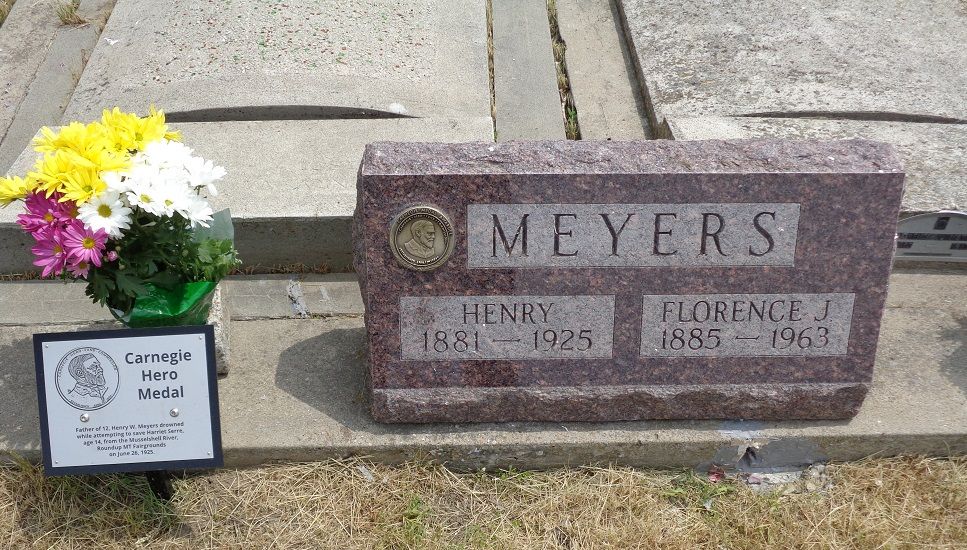

Carnegie Medal awardee Henry W. Meyers died in 1925 attempting to rescue a 14-year-old girl from drowning, and his extended family is making certain his memory is kept alive.
In August, during a family reunion in Roundup, Mont., Meyers was honored for his heroic deed.
The Meyers family affixed a Carnegie Hero grave marker to his headstone in Roundup City Cemetery and installed an aluminum plaque next to the grave, which has the words that appear on the cartouche of Meyers’s Carnegie Medal — “Henry W. Meyers died attempting to save Harriet Serre from drowning, Roundup, Montana, June 26, 1925.”
Meyers’s medal, a second plaque, newspaper articles, and photos are currently on display at the Musselshell Valley Historical Museum in Roundup.
The reunion allowed members of the family to see the medal, a majority of them for the first time. According to Meyers’s great-granddaughter, Mari Hoiland, most relatives knew Meyers had drowned at age 44, but did not know the full story, and only three of the 61 family reunion attendees had seen the medal.
At the gathering they were able to examine the medal, which had been “tucked away in a closet and seen by a handful over the years,” according to an article in a family newsletter prepared by Hoiland.
Hoiland’s uncle David Lloyd, son of Meyers’s daughter Verna, received the medal in the last decade from distant relatives in South Dakota. Lloyd then loaned it to the museum. Meyers’s medal had been on display at least once before, in a storefront window in Roundup in 1926, the year Meyers was awarded.
The family organized a luncheon at the Masonic Hall in Roundup the weekend of the reunion. Hoiland said when she walked into the hall, there was a photograph of Arthur Dye, a Mason and the man who had nominated her great-grandfather for the Carnegie Medal. Dye, who had also served as Roundup’s mayor, had never made public the fact that he had been the one to nominate Meyers, and the family discovered this fact before their reunion.
Meyers’s last day of his life began as a presumably normal one. He went to work as a laborer, making concrete blocks with another man near the Musselshell River in Roundup. Meyers heard screams coming from the river, and he and the other man ran to the water, where he saw the girl struggling and shouting for help.
Meyers, who could not swim, entered the water with a fishing pole and extended it to the girl, who grasped it. Meyers was knocked off of his feet and pulled underneath the surface of the water. The girl was able to get out of the water, but Meyers died; his body was recovered three days later.
According to an article in the Roundup Record-Tribune in 2006, the location of the drowning was close to a pavilion near the river, and many of the blocks in the original portion of the pavilion were made by Meyers.
Meyers was also a farmer and worked part-time for the city of Roundup.
Meyers left a behind a wife and 12 children, the youngest child a 1-year-old daughter. Meyers’s widow, Florence, received a monthly grant from the commission beginning in 1926 and continuing until her death in 1963.
According to Hoiland, Florence never complained about her circumstances, and had help from her older children, neighbors, and members of her church.
Due to the concerns that someone else might drown in the river, the community, including members of the Meyers family, raised some of the funds needed to have a community pool built in Roundup.
— Susan M. Rizza, case investigator

